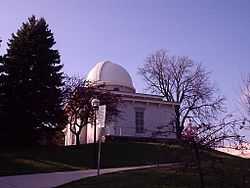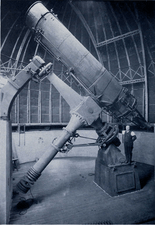Detroit Observatory
|
Detroit Observatory | |
 | |
|
Detroit Observatory | |
 | |
| Location | Observatory and Ann Sts., Ann Arbor, Michigan |
|---|---|
| Coordinates | 42°16′54″N 83°43′54″W / 42.28167°N 83.73167°WCoordinates: 42°16′54″N 83°43′54″W / 42.28167°N 83.73167°W |
| Area | less than one acre |
| Built | 1853 |
| Built by | George Bird |
| Architect | Richard Harrison Bull |
| Architectural style | Greek Revival, Italianate |
| Governing body | State |
| NRHP Reference # | 73000960[1] |
| Significant dates | |
| Added to NRHP | September 20, 1973 |
| Designated MSHS | February 19, 1958[2] |
The Detroit Observatory is located on the corner of Observatory and Ann streets in Ann Arbor, Michigan. It was built in 1854, and was the first scientific research facility at the University of Michigan and the oldest observatory of its type in the nation.[2] It was designated a Michigan State Historic Site in 1958[2] and placed on the National Register of Historic Places in 1973.[1]
Building the Observatory
Henry Philip Tappan was inaugurated as the president of the University of Michigan in December 1852, and in his inaugural speech, appealed to the citizens of Michigan to support research and laboratory space at the University.[3] Immediately afterward, Tappan was approached by Detroit businessman (and former Michigan Attorney General) Henry N. Walker, who offered assistance. Tappan suggested raising funds for an observatory, and Walker agreed to spearhead a fundraising drive. Walker soon raised $15,000 from the citizens of Detroit, including $4000 of his own money, and contributions from Lewis Cass, Henry Porter Baldwin, and Senator Zachariah Chandler. An additional $7000 was supplied by the Board of Regents of the University of Michigan, giving a total of $22,000 for the building and instruments.[3]
In 1853, land in Ann Arbor was obtained for the building site, and George Bird of New York was hired to superintend construction of the building. To design the building, Tappan turned to Richard Harrison Bull, a New York University civil engineering professor, amateur astronomer, and former student of Tappan's.[4][5] Construction was completed in 1854, and the building was named the Detroit Observatory to recognize the benefactors who funded its construction.[3] The building housed a 12⅝-inch (32 cm) Henry Fitz, Jr. refracting telescope in the central area. The Fitz was the third largest telescope in the world when it was installed in 1857. A 6-inch (15 cm) Pistor & Martins meridian circle was installed in the east wing, while the west wing served as a library and office space for the director.[3]
Later history

In 1890, the dome rotation mechanisms were revamped.[5] In 1868, a director's residence was added on the west end of the building.[3] The residence was enlarged and improved in 1905-06, and another, larger wing containing academic and office space was added in 1908. The 1908 addition included a second dome and space for a new 37 1/2-inch reflecting telescope.[6] The director's residence was demolished in 1954 to make way for the expansion of nearby Couzens Hall; the 1908 addition was demolished in 1976.[6]
The astronomy department moved from the building in 1963, and the Detroit Observatory was used first as a library, then as a storeroom.[6][7] It soon became derelict, and in the 1970s was threatened with complete demolition. However, the building was placed on the National Register of Historic Places in 1973, and restored in 1997-98. In 2005, the Detroit Observatory became a division of the Bentley Historical Library.
The function of the Detroit Observatory on campus was taken over by the Angell Hall Observatory which was completed much later. The "Observatories of the University of Michigan" include the Detroit Observatory (1854), the Angell Hall Observatory (1927), the Lamont-Hussey Observatory (South Africa, 1928) and the McMath-Hulbert Observatory (Lake Angelus, MI, 1930).
Observatory directors and notable students
Tappan recruited Franz Brünnow as the first director of the observatory in 1854.[8] Among Brünnow's students dring his tenure at the Detroit Observatory were Asaph Hall, DeVolson Wood, Cleveland Abbe, and James Craig Watson.[5] Brünnow stayed until 1863, when he was succeeded by James Craig Watson. Watson served for 16 years, and among his students were Otto Julius Klotz, Robert Simpson Woodward, George Cary Comstock, Marcus Baker, and John Martin Schaeberle.[5] The full list of directors of the Detroit Observatory is as follows:[8]
| Name | Dates of service | Notes |
|---|---|---|
| Franz Brünnow | 1854-1863 | |
| James Craig Watson | 1863-1879 | |
| Mark W. Harrington | 1879-1891 | |
| Asaph Hall, Jr. | 1892-1905 | |
| William J. Hussey | 1905-1926 1891-1892 (acting) |
|
| Ralph H. Curtiss | 1927-1929 1926 (acting) |
|
| Heber D. Curtis | 1930-1941 | |
| W. Carl Rufus | 1929-1930 (acting) 1942-1945 (acting) |
|
| A. D. Maxwell | 1945-1946 (acting) | |
| Leo Goldberg | 1946-1960 | |
| Freeman D. Miller | 1960-1961 (acting) | |
| Orren C. Mohler | 1962-1970 | |
| W. Albert Hiltner | 1970-1982 |
Building description
The Detroit Observatory, located on the campus of the University of Michigan, is a two-story hip roof rectangular frame structure, 33 feet (10 m) on a side, flanked by two one-story wings, each 19 feet (5.8 m) by 29 feet (8.8 m).[2][3] The design is typical of observatories built in the 19th century.[5] The structure is constructed of solid brick clad with stucco painted to resemble granite blocks.[5] It is capped with a large revolving dome built of wood and canvas, 21 feet (6.4 m) in diameter. A small portico covers the front entrance.
References
- ↑ 1.0 1.1 "National Register Information System". National Register of Historic Places. National Park Service. 2010-07-09.
- ↑ 2.0 2.1 2.2 2.3 "Detroit Observatory-University of Michigan". Michigan State Housing Development Authority: Historic Sites Online. Retrieved December 31, 2012.
- ↑ 3.0 3.1 3.2 3.3 3.4 3.5 "Detroit Observatory". Bentley Historical Library, University of Michigan. Retrieved December 31, 2012.
- ↑ People Who Shaped The Detroit Observatory, Bentley Historical Library, University of Michigan, retrieved December 31, 2012
- ↑ 5.0 5.1 5.2 5.3 5.4 5.5 Patricia S. Whitesell (2003), "Detroit Observatory: nineteenth-century training ground for astronomers", Journal of Astronomical History and Heritage 6 (2): 69–106, Bibcode:2003JAHH....6...69W
- ↑ 6.0 6.1 6.2 The Buildings of the Detroit Observatory, Bentley Historical Library, University of Michigan, retrieved December 31, 2012
- ↑ Detroit Observatory Chronology: 1961-present, Bentley Historical Library, University of Michigan, retrieved December 31, 2012
- ↑ 8.0 8.1 Hall of Directors, Bentley Historical Library, University of Michigan, retrieved December 31, 2012
Further reading
| Wikimedia Commons has media related to Detroit Observatory. |
- Patricia S. Whitesell (1998), A creation of his own: Tappan's Detroit Observatory, Michigan Historical Collections, Bentley Historical Library, University of Michigan, ISBN 0472590065
| ||||||||||||||||||||||||||